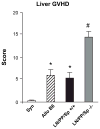Secondary lymphoid organs contribute to, but are not required for the induction of graft-versus-host responses following allogeneic bone marrow transplantation: a shifting paradigm for T cell allo-activation
- PMID: 20117226
- PMCID: PMC3838892
- DOI: 10.1016/j.bbmt.2009.12.007
Secondary lymphoid organs contribute to, but are not required for the induction of graft-versus-host responses following allogeneic bone marrow transplantation: a shifting paradigm for T cell allo-activation
Abstract
Graft-versus-host disease (GVHD) remains the major complication of allogeneic bone marrow transplantation (allo-BMT). GVHD fundamentally depends upon the activation of donor T cells by host antigen-presenting cells (APCs), but the precise location of these interactions remains uncertain. We examined the role of secondary lymphoid organs (SLO) in the induction of GVHD by using homozygous aly/aly mice that are deficient in lymph nodes (LNs) and Peyer's patches (PPs). Lethally irradiated, splenectomized, aly/aly (LN/PP/Sp-/-) mice and sham-splenectomized, aly/+ (LN/PP/Sp+/+) mice received BMT from either syngeneic (aly/aly) or allogeneic, major histocompatibility complex (MHC) disparate donors. Surprisingly, although LN/PP/Sp-/- allo-BMT recipients experience a survival advantage, they developed significant systemic and target organ GVHD that is comparable to LN/PP/Sp+/+ controls. Early after allo-BMT, the activation and proliferation of donor T cells was significantly greater in the BM cavity of LN/PP/Sp-/- mice compared to LN/PP/Sp+/+ controls. Donor T cells in LN/PP/Sp-/- mice demonstrated cytolytic activity in vitro, but Graft vs Leukemia (GVL) activity could be overcome by increasing the tumor burden. These data suggest that SLO contribute to, but are not required for, allogeneic T cell responses, and suggest that the BM may represent an alternative, albeit less efficient site for T cell activation following allo-BMT.
Copyright 2010 American Society for Blood and Marrow Transplantation. Published by Elsevier Inc. All rights reserved.
Figures

 compared to T cells only
compared to T cells only
 .
.
 ; allo-C57BL/6 cont ▨; LN/PP/Sp+ ■; LN/PP/Sp−/−
; allo-C57BL/6 cont ▨; LN/PP/Sp+ ■; LN/PP/Sp−/−
 .
.
 LN/PP/Sp−/− ■.
LN/PP/Sp−/− ■.
 ; allo C57BL/6 ▨; LN/ PP/Sp+/+ ■; LN/PP/Sp−/−
; allo C57BL/6 ▨; LN/ PP/Sp+/+ ■; LN/PP/Sp−/−
 .
.


Similar articles
-
Ceacam1 separates graft-versus-host-disease from graft-versus-tumor activity after experimental allogeneic bone marrow transplantation.PLoS One. 2011;6(7):e21611. doi: 10.1371/journal.pone.0021611. Epub 2011 Jul 6. PLoS One. 2011. PMID: 21760897 Free PMC article.
-
Donor T-Cell Repertoire Profiling in Recipient Lymphoid and Parenchyma Organs Reveals GVHD Pathogenesis at Clonal Levels After Bone Marrow Transplantation in Mice.Front Immunol. 2021 Dec 7;12:778996. doi: 10.3389/fimmu.2021.778996. eCollection 2021. Front Immunol. 2021. PMID: 34950143 Free PMC article.
-
IL-11 separates graft-versus-leukemia effects from graft-versus-host disease after bone marrow transplantation.J Clin Invest. 1999 Aug;104(3):317-25. doi: 10.1172/JCI7111. J Clin Invest. 1999. PMID: 10430613 Free PMC article.
-
T-cell co-signalling molecules in graft-versus-host disease.Ann Hematol. 2000 Jun;79(6):283-90. doi: 10.1007/s002779900134. Ann Hematol. 2000. PMID: 10901605 Review.
-
Alloreactivity and the predictive value of anti-recipient specific interleukin 2 producing helper T lymphocyte precursor frequencies for alloreactivity after bone marrow transplantation.Dan Med Bull. 2002 May;49(2):89-108. Dan Med Bull. 2002. PMID: 12064093 Review.
Cited by
-
Future perspectives: should Th17 cells be considered as a possible therapeutic target in acute myeloid leukemia patients receiving allogeneic stem cell transplantation?Cancer Immunol Immunother. 2011 Dec;60(12):1669-81. doi: 10.1007/s00262-011-1118-z. Epub 2011 Oct 12. Cancer Immunol Immunother. 2011. PMID: 21989580 Free PMC article. Review.
-
Pathophysiology and preclinical relevance of experimental graft-versus-host disease in humanized mice.Biomark Res. 2024 Nov 14;12(1):139. doi: 10.1186/s40364-024-00684-9. Biomark Res. 2024. PMID: 39543777 Free PMC article. Review.
-
The Biology of Chronic Graft-versus-Host Disease: A Task Force Report from the National Institutes of Health Consensus Development Project on Criteria for Clinical Trials in Chronic Graft-versus-Host Disease.Biol Blood Marrow Transplant. 2017 Feb;23(2):211-234. doi: 10.1016/j.bbmt.2016.09.023. Epub 2016 Oct 3. Biol Blood Marrow Transplant. 2017. PMID: 27713092 Free PMC article. Review.
-
In vivo dynamics of T cells and their interactions with dendritic cells in mouse cutaneous graft-versus-host disease.Blood Adv. 2019 Jul 23;3(14):2082-2092. doi: 10.1182/bloodadvances.2019000227. Blood Adv. 2019. PMID: 31296496 Free PMC article.
-
Regional intra-arterial steroid treatment in 120 patients with steroid-resistant or -dependent GvHD.Bone Marrow Transplant. 2017 Oct;52(10):1416-1422. doi: 10.1038/bmt.2017.120. Epub 2017 Jun 26. Bone Marrow Transplant. 2017. PMID: 28650453 Clinical Trial.
References
-
- Murai M, Yoneyama H, Ezaki T, et al. Peyer’s patch is the essential site in initiating murine acute and lethal graft-versus-host reaction. Nat Immunol. 2003;4:154–160. - PubMed
-
- Miyawaki S, Nakamura Y, Suzuka H, et al. A new mutation, aly, that induces a generalized lack of lymph nodes accompanied by immunodeficiency in mice. Eur J Immunol. 1994;24:429–434. - PubMed
-
- Yamada T, Mitani T, Yorita K, et al. Abnormal immune function of hemopoietic cells from alymphoplasia (aly) mice, a natural strain with mutant NF-kappa B-inducing kinase. J Immunol. 2000;165:804–812. - PubMed
Publication types
MeSH terms
Grants and funding
LinkOut - more resources
Full Text Sources
Medical
Research Materials
Miscellaneous

